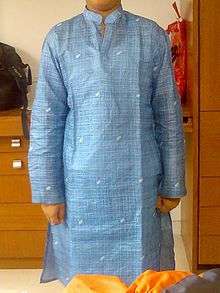Khadi
Khadi (pronounced [kʰaːd̪iː]; IAST: Khadi) or Khaddar is a term for handspun and hand-woven cloth from India, Bangladesh and Pakistan mainly made out of cotton.
The cloth is usually woven from cotton and may also include silk, or wool, which are all spun into yarn on a spinning wheel called a charkha. It is a versatile fabric, cool in summer and warm in winter. In order to improve the look, khādī/khaddar is sometimes starched to give it a stiffer feel. It is widely accepted in fashion circles.[1] Khadi is being promoted in India by Khadi and Village Industries Commission, Ministry of MSME Govt. of India.
India

In India, Khadi is not just a cloth, it is a whole movement started by Mohandas Karamchand Gandhi.[2] The Khadi movement promoted a socio-cultural aesthetic, an idea that Indians could be self-reliant on cotton and be free from foreign cloth and clothing.
British were selling to them very high cost cloths. The British would buy cotton from India at cheap prices and export it to Britain where it was woven to make clothes. These clothes were then brought back to India to be sold at hefty prices. The khadi movement aimed at boycotting foreign goods including cotton and promoting Indian goods, thereby improving India's economy. Mahatma Gandhi began promoting the spinning of khādī for rural self-employment and self-reliance (instead of using cloth manufactured industrially in Britain) in 1920s India, thus making khadi an integral part and icon of the Swadeshi movement. The freedom struggle revolved around the use of khādī fabrics and the dumping of foreign-made clothes. When some people complained about the costliness of khadi to Mahatma Gandhi, he started wearing only dhoti.
Various state governments and the Government of India have been appealing to citizens to promote the usage of Khadi.[3][4]
Bangladesh
Khadi, also known as "khaddar" has a long history in Bangladesh. In the 6th century a local variation of Khadi cloth was described by Huen Tsang of China and Marco Polo in the 12th century AD describes a fabrics, most probably khadi Muslin in the Bengal region to be as fine as the spider’s web.[5]
Romans were great aficionados of Bengal khadi Muslin and imported vast amounts of fabrics. The khadi weaves of Comilla during the Mughal period were renowned as valuable textiles with distinctive characteristics.[6]
During the years of the Indian self-rule movement and later with the independence of Bangladesh the spirit of khadi was driven with the winds of change. In 1921 Gandhi came to Chandina Upazila in comilla to inspire the local weavers and consequently a branch of 'Nikhil Bharat Tantubai Samity' was established to self-seed and proliferate the sale of goods to other major cities in India.[7]
In greater Comilla region the weaving centers were particularly developed in Mainamati, Muradnagar, Gauripur and Chandina.
2016
See also
References
- ↑ "Khadi Culture, By Abhishek Mangla www.khadiculture.com".
- ↑ Selin, Helaine (1997). Encyclopaedia of the History of Science, Technology, and Medicines in Non- Western Cultures. The Netherlands: Kluwer Academic Publishers. p. 961. ISBN 0792340663.
- ↑ "Saturday Dressing: Kerala govt staff opt for khadi". Business Standard. Business Standard. Retrieved 20 March 2016.
|first1=missing|last1=in Authors list (help) - ↑ "Mann Ki Baat: PM Modi urges India to embrace Gandhi's legacy 'Khadi'". Zee News. Zee News.
- ↑ "Cosy Comfort: Khadi". bdnewslive.com. Retrieved 2014-01-14.
- ↑ "Khadi Reviving the Heritage". the daily star (Bangladesh). Retrieved 2014-01-14.
- ↑ "The story of KHADI". the daily star (Bangladesh). Retrieved 2014-01-14.
External links
| Wikimedia Commons has media related to Khādī. |
- Khadi Culture: Fabrics from the roots of a nation!
- India's Khādī Culture
- Khadi and Village Industries Commission (Govt of India), Official website
- More about Khadi


.svg.png)